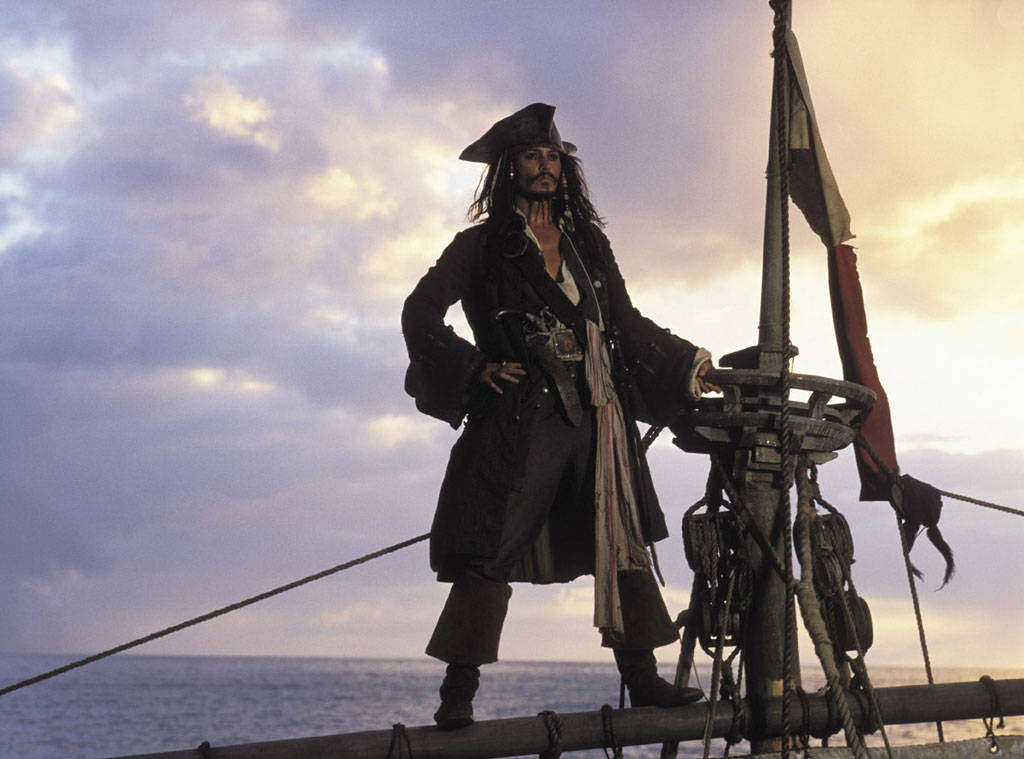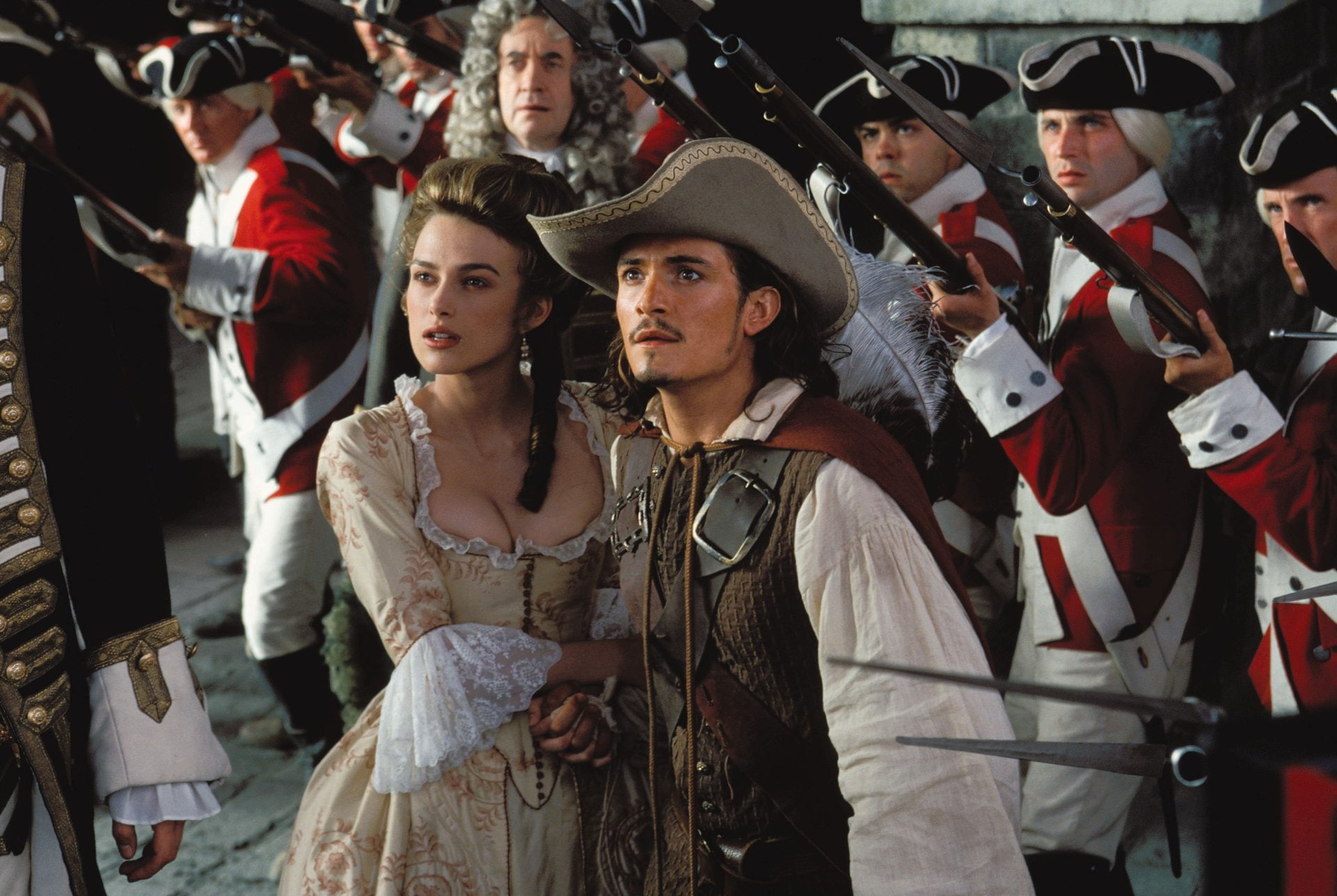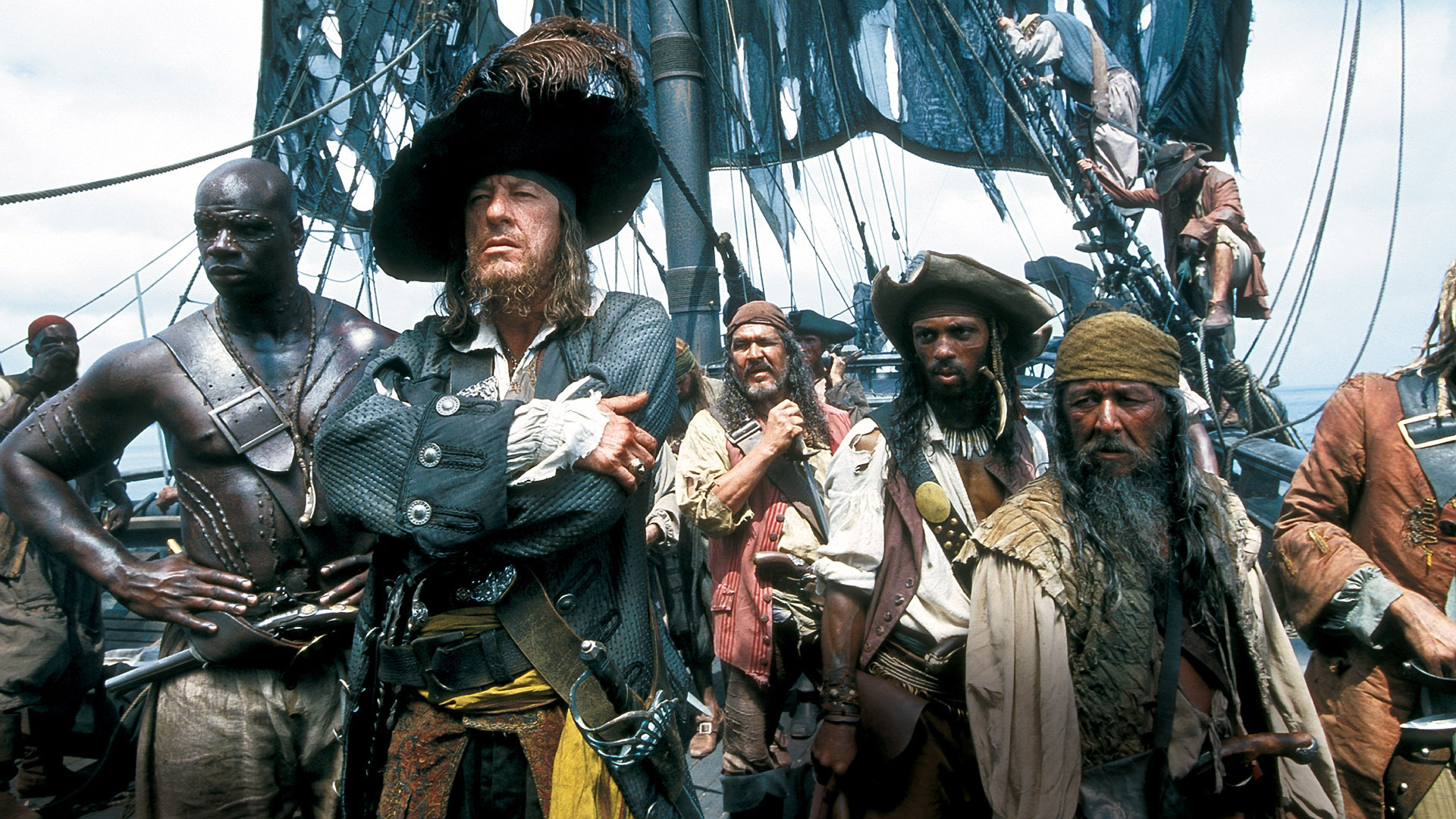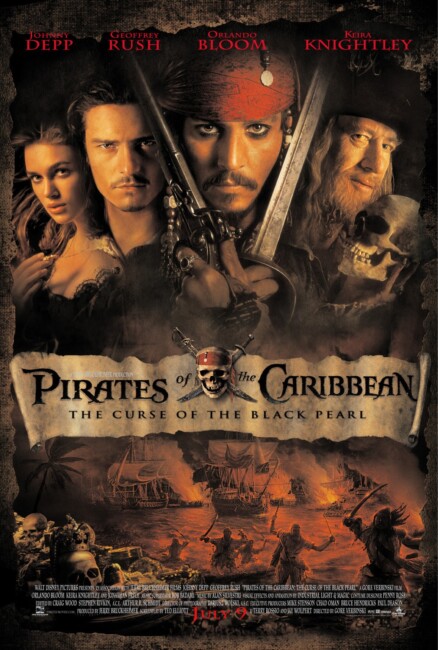USA. 2003.
Crew
Director – Gore Verbinski, Screenplay – Ted Elliott & Terry Rossio, Story – Stuart Beattie, Ted Elliott, Terry Rossio & Jay Wolpert, Producer – Jerry Bruckheimer, Photography – Dariusz Wolski, Music – Klaus Badelt, Music Supervisor – Rob Badani, Visual Effects Supervisor – John Knoll, Visual Effects – Industrial Light and Magic, Additional Visual Effects – Boy Wonder (Supervisor – Tim Landry), CIS (Supervisor – Brian Hirota), Digiscope, Grey Matter FX, Method & Pacific Title, Previsualization – Pixel Liberation Front, Special Effects Supervisor – Terry Frazee, Makeup Effects Supervisors – Ve Neill & Keith Vanderlaan, Makeup Effects – Captive Audience, Creature Concepts – Crash McCreery, Makeup Consultant – Greg Cannom, Production Design – Brian Morris. Production Company – Disney/Jerry Bruckheimer Pictures/First Mate Productions.
Cast
Johnny Depp (Captain Jack Sparrow), Orlando Bloom (Will Turner), Keira Knightley (Elizabeth Swann), Geoffrey Rush (Captain Barbossa), Jack Davenport (Commodore Norrington), Jonathan Pryce (Governor Weatherby Swann), Lee Arenberg (Pintel), Mackenzie Crook (Ragetti), Kevin R. McNally (Mr Gibbs), Giles New (Murtogg), Angus Barnett (Mullroy), Damian O’Hare (Lieutenant Gillette), Zoe Saldana (Anna-Maria)
Plot
The pirate Jack Sparrow arrives in Port Royal as his ship sinks. He is just in time to save the British governor’s daughter Elizabeth Swann after she faints and falls into the ocean, only to be locked up in the jail by the officious Commodore Norrington who is planning to marry Elizabeth. Port Royal is then attacked by the pirates of the dreaded Black Pearl, Jack’s former command, and Elizabeth abducted. When Norrington refuses to go after her, the blacksmith Will Turner, who loves Elizabeth, frees Jack on the agreement that he lead him after the Black Pearl. As they steal a ship and set sail, Will learns the truth about his pirate father and how the crew of the Black Pearl are doomed to wander the seas as living corpses as a result of picking up cursed Aztec gold coins – something that can only be remedied by the shedding of Will’s blood.
Pirates of the Caribbean: The Curse of the Black Pearl was one of the big surprise hits of the 2003 American summer season. It seemed the unlikeliest of hits in many ways. It is hard to think of how long it had been since there was a pirate movie that had been a success. One might be better of looking at the number of pirate movies that were flops over the last 30 years – think of The Light at the Edge of the World (1971), Swashbuckler (1976), The Island (1980), Savage Island/Nate and Hayes (1983), The Goonies (1985), The Pirate Movie (1982), Roman Polanski’s Pirates (1986), and the notorious CutThroat Island (1995), which have all given strong indication that the pirate genre had long departed for Davy Jones’s Locker, along with the Western. Sometimes there is no figuring what trends are going to pop up again at random – indeed, 2003 seems to be give strong indication that the pirate genre was back with a full sail of wind, with Peter Weir’s more serious minded Master and Commander: The Far Side of the World (2003) and the live-action remake of Peter Pan (2003) also appearing on screens.
At face value, Pirates of the Caribbean makes you scratch your head. First there was the idea of a team-up between Disney and Jerry Bruckheimer, the king of load and noisy action bombast – Con Air (1997), Armageddon (1998), Gone in 60 Seconds (2000), Pearl Harbor (2001) et al. And then there is trying to stretch one’s mind around the concept of the testostoronally-hyped Jerry Bruckheimer trying to make a film out of a Disney theme park ride. In this case, the film comes from the Disneyland attraction The Pirates of the Caribbean, which originally premiered in 1967, wherein audiences are taken through a staged pirate adventure featuring a combination of actors and animatronics.
One suspects that the thinking at Disney is less to do with reviving the pirate movie than in spinning another movie off one of their theme park as they had successfully done with The Country Bears (2002) the previous holiday season. In recent years, Disney has creatively ransacked their basement and recycled all their past hits – first as tv movies, then by remaking their animated classics in live-action and sequelizing most of their animated classics, while movies based on their theme park rides appeared to be the latest trend – Pirates of the Caribbean: The Curse of the Black Pearl was followed only a few months later by The Haunted Mansion (2003) based on yet another theme park ride and the subsequent Tomorrowland (2015) and Jungle Cruise (2021).

Elsewhere, Disney have assembled an odd stew of talents. The script comes from the writing team of Ted Elliott and Terry Rossio who have between them crafted Disney’s Aladdin (1992) and Treasure Planet (2002) and other animation works like Antz (1998), The Road to El Dorado (2000) and Shrek (2001), as well as the live-action likes of Godzilla (1998) and The Mask of Zorro (1998).
In the director’s chair is Gore Verbinski. Gore Verbinski is a frank mystery man as a director. He has a chameleon-like ability to shift and adopt other styles – from the live-action Tom and Jerry cartoon of MouseHunt (1997) to the flop Magical Realist romance-thriller The Mexican (2001), the hit of the effective English-language remake of The Ring (2002) and the subsequent gonzo animated Rango (2011), the flop big screen version of The Lone Ranger (2013) and A Cure for Wellness (2016) about a sinister health sanatorium – while leaving almost no discernible imprint of his own on the film. All of Gore Verbnski’s films so far have rested within the fantasy genre in one way or another with the exception of the comedy The Weather Man (2005).
Pirates of the Caribbean: The Curse of the Black Pearl emerges as a likeable film, although one that falls short of the lavish degree of praise that has been heaped on it by the largely younger audience. It is not so much a pirate adventure as it is a work that invites its audience into a shared comedic treatment of the clichés of the genre. It is not even the first film to do this – the idea has been done before by the Burt Lancaster vehicle The Crimson Pirate (1952), a likeably unserious spoof of the pirate movie that literally invited its audience to take only half of what they saw seriously, and which did things a good deal better than Pirates of the Caribbean. Another film that Pirates of the Caribbean closely resembles is The Princess Bride (1987). The Princess Bride was peripherally a swashbuckler, mostly a fairytale, but both are films that take a known genre and aim to give audiences a grand old adventure while also winking at the familiar clichés with a knowing sense of humour.
Pirates of the Caribbean covers fairly much every trope of the pirate movie genre – the kidnapped heroine, the black-hearted brigand, the romantic hero, the pompous British Naval officer, the pirate treasure, scenes walking the plank, the hero in the brig, the wenches, the hero abandoned on a desert island, the boarding of the ships. There are a few modern additions that the original pirate movies never tried – such as the addition of a horde of cursed undead buccaneers (which is what gives Pirates of the Caribbean inclusion as a fantasy film here) in a plot that makes it emerge as something like The Crimson Pirate meets Army of Darkness (1992).
All of this comes considerably tongue-in-cheek, where the filmmakers often seem to be defying the audience to find some of the things as improbable as they intend them. This is surely twigged by Johnny Depp’s rather funny entrance – where Gore Verbinski starts out with what looks like Depp on the crow’s nest surveying the ocean, before pulling back to show him standing on about the remaining three metres of his ship’s sinking mast and deftly stepping off onto the dock as it sails into port and sinks beneath the waters.

It all swashes and buckles enjoyably. Although ultimately, Pirates of the Caribbean never amounts to much more than an amiable crowd-pleaser and certainly falls short of the classic label it was instantly slapped with. There is a good deal of fun to be had in the first half with Johnny Depp’s comic encounters with various members of the British Navy, both pompous and dim-witted; the duels between he and Orlando Bloom; Keira Knightley’s abduction by the comic pirates; and with Geoffrey Rush on grand form as the pirate captain. It is in these scenes that the film gets the balance right and suggests for a time that it is going to be another equivalent of The Princess Bride in its tongue-in-cheek blend of clichés and adventure. However, Ted Elliott and Terry Rossio never let the dialogue dance with the grandiloquent joy that screenwriter William Goldman did in The Princess Bride.
Pirates of the Caribbean‘s main failing is that the bulk of the adventure is overly long. Rossio and Elliott’s script twists and turns with entertaining dexterity but there are a few too many pirate battles, too many scenes with various people being captured, rescued, thrown in the brig, shifting sides and so on. The film goes on for at least 20 minutes longer than it should have. More importantly, considering that this is a Jerry Bruckheimer film, which consists almost entirely of constant credibility-defying mindless spectacle, Gore Verbinski never lets the film pay off with the big, big climax that you feel it is heading towards.
The film’s greatest success is the cast. There is Orlando Bloom, in his first major role outside of The Lord of the Rings, and proving himself worthy of the sex symbol status he has been acclaimed as. Bloom holds the screen considerably, convincing one of both Will’s moral stature and projecting a romantic leading man forthrightness. Opposite him is eighteen year-old Keira Knightley, snapped up from the British crossover hit Bend it Like Beckham (2002), who plays with a refreshingly independent presence and fire. Both Bloom and Keira Knightley show their capabilities head and shoulder above the rest of their contemporaries as being handsome stars who also have an ability to act, something that was backed up by Knightley’s being nominated for an Academy Award two years later. (She became a major name but Orlando Bloom oddly disappeared from the scene). Geoffrey Rush seems to be having the time of his life, chewing the scenery with wonderfully loathsome presence as the villain of the show.
The one performance that everybody invariably emerged talking about was that of Johnny Depp. It is a performance that had Johnny Depp re-acclaimed as a star all over again (not that one was aware he ever went away). Depp is one of this author’s favourite actors – he parlayed his emergence as a teen idol in the 1980s into a series of enjoyably off-centre performances in films like Edward Scissorhands (1990), Ed Wood (1994), Don Juan de Marco (1995) and Fear and Loathing in Las Vegas (1998) and prefers to work with maverick, creatively invigorating names like Terry Gilliam, Roman Polanski, Robert Rodriguez, Tim Burton and John Waters rather than do mainstream fare.

Depp was unexpectedly nominated for an Academy Award for the role in Pirates of the Caribbean: The Curse of the Black Pearl. Depp is certainly well overdue award recognition but what a performance to be so acclaimed for. Depp claims to have based Jack Sparrow on a combination of The Rolling Stones’ Keith Richards and Pepe Le Pew from the Warner Brothers cartoons. In mascara, braided beard, a mouthful of gold teeth, Op Shop pirate fashion, a seemingly drunken gait and doing all his acting with rolls of his eyes and fey waves of his hand, it is one of the most eccentric leading man performances in a major blockbuster this year and several others for that matter.
Nitpickers corner:– Pirates of the Caribbean: The Curse of the Black Pearl is not exactly a film where you are invited to ponder the historical accuracy. Nevertheless, it does come with a number of glaring anachronisms. The film’s setting is supposedly the great age of piracy in the Caribbean, which began circa 1680 and ended around 1730 when the British Navy’s iron control of the seas in the area pushed pirates out of their Jamaican bases. The film claims its principal setting as Port Royal [Jamaica], but Port Royal was completely destroyed in an earthquake in 1692. At the same time the film makes reference to Singapore, although Thomas Raffles did not found Singapore until 1819. At a later point, two of the undead pirates have a gag making reference to Pinocchio’s extending nose – however Carlo Collodi’s Pinocchio was not written until 1881, more than a century after the Age of Piracy had come to an end.
Gore Verbinksi, Jerry Bruckheimer, Ted Elliott, Terry Rossio, Johnny Depp and all of the lead cast returned in two sequels, Pirates of the Caribbean: Dead Man’s Chest (2006) and Pirates of the Caribbean: At World’s End (2007). This was followed by two further entries with Pirates of the Caribbean: On Stranger Tides (2011) and Pirates of the Caribbean: Dead Men Tell No Tales/Pirates of the Caribbean: Salazar’s Revenge (2017).
The screenwriting team of Ted Elliott and Terry Rossio’s have combined on a number of other screenplays including Little Monsters (1989), Disney’s Aladdin (1992), The Puppet Masters (1994), the remake of Godzilla (1998), The Mask of Zorro (1998), Small Soldiers (1998), The Road to El Dorado (2000), Shrek (2001) and Disney’s Treasure Planet (2002). Terry Rossio on his own co-wrote Deja Vu (2006) and Godzilla vs. Kong (2021).
(Nominee for Best Actor (Johnny Depp) and Best Actress (Keira Knightley) at this site’s Best of 2003 Awards. No. 3 on the SF, Horror & Fantasy Box-Office Top 10 of 2003 list).
Trailer here


